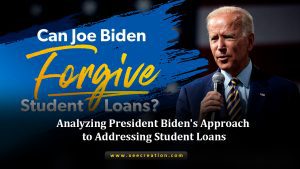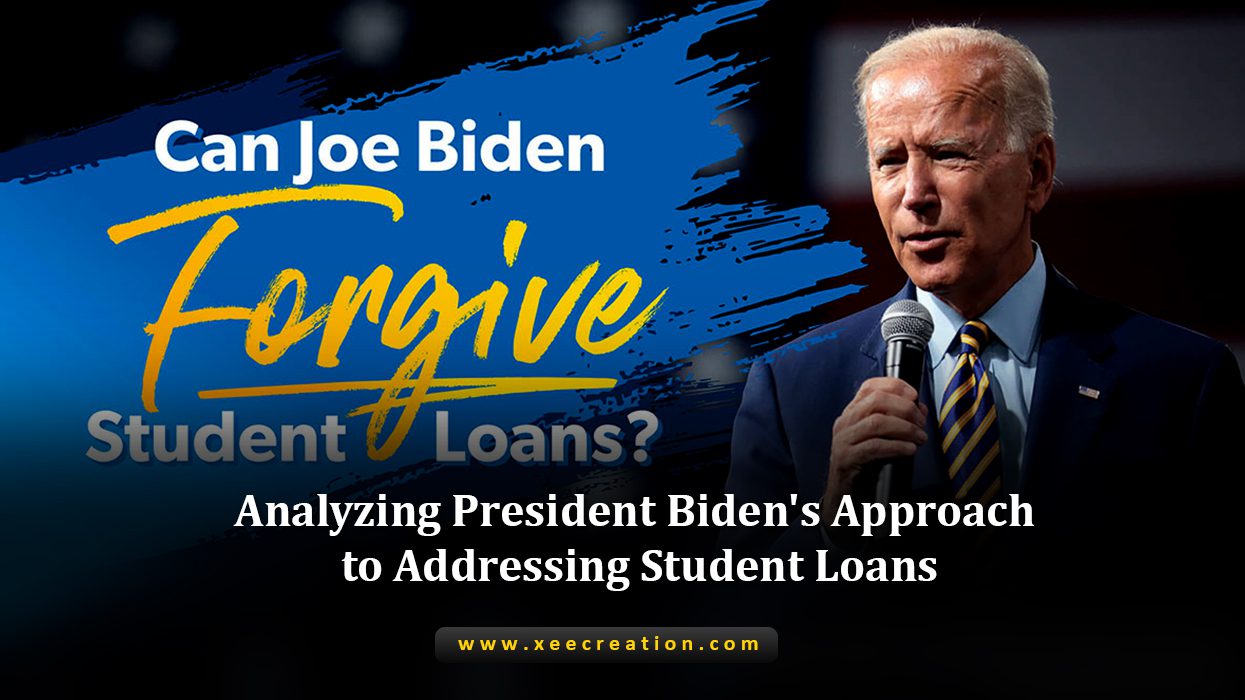Analyzing President Biden’s Approach to Addressing Student Loans: A Comprehensive Review

Introduction Student Loans:
President Joe Biden has consistently emphasized the importance of higher education and reduced student loan burden on American households. Since taking office, his administration has implemented several initiatives and proposals to address the student loan crisis. This article analyzes President Biden’s approach to tackling student loans, examining key policies, proposals, and potential implications.
- Overview of the Student Loan Crisis: Before delving into President Biden’s approach, it is essential to understand the gravity of the student loan crisis. This section explores the current state of student debt in the United States, its impact on borrowers and the economy, and the challenges it presents.
- The American Rescue Plan Act: One of President Biden’s initial actions was signing the American Rescue Plan Act into law. This section outlines how the legislation relieves student loan borrowers, including temporary suspension of payments and interest, expansion of income-driven repayment plans, and tax-free forgiveness for specific borrowers.
- Student Loan Forgiveness: President Biden has expressed support for student loan forgiveness, albeit with specific parameters. This section examines his proposals for targeted forgiveness, such as forgiving debt for low-income borrowers, public service workers, and those who attended for-profit institutions. It also explores the challenges and controversies associated with broader-scale forgiveness.
- Reforming Income-Driven Repayment Plans: The Biden administration aims to revamp income-driven repayment plans to make them more accessible and practical. This section delves into proposed changes, such as capping monthly payments at a certain percentage of borrowers’ incomes and streamlining the forgiveness process.
- Expanding Public Service Loan Forgiveness: Public service workers play a vital role in society, and President Biden intends to expand loan forgiveness programs for these individuals. This section discusses the administration’s plans to simplify the Public Service Loan Forgiveness program and increase awareness among eligible borrowers.
- Addressing Predatory Practices and For-Profit Institutions: The for-profit education sector has often been associated with predatory practices and high student loan default rates. President Biden aims to hold these institutions accountable and protect student borrowers. This section explores measures to regulate for-profit colleges, enhance transparency, and strengthen borrower protections.
- College Affordability and Free Community College: President Biden has proposed various initiatives, such as tuition-free community college for eligible students, to make higher education more affordable. This section examines the potential impact of these proposals on access to education and student loan borrowing.
- Future Challenges and Potential Implications: Implementing significant reforms to the student loan system poses challenges and can have far-reaching consequences. This section explores the potential economic, political, and social implications of President Biden’s approach to student loans and discusses the outlook for future reforms.
Conclusion:
President Biden’s approach to addressing student loans reflects his commitment to reducing borrowers’ burdens and making higher education more accessible. While his initiatives hold the potential to alleviate the student loan crisis, challenges and controversies persist. By critically analyzing these policies and proposals, we can better understand their impact on individuals, the economy, and the broader landscape of higher education in the United States.
Certainly! Here are some frequently asked questions (FAQs) regarding the most recent updates on President Biden’s approach to student loans:
- Has President Biden made any progress in providing relief for student loan borrowers? President Biden has taken significant steps to provide relief for student loan borrowers. The American Rescue Plan Act, signed into law in March 2021, included provisions for suspending federal student loan payments and interest until September 30, 2021. Additionally, the Department of Education has been working on implementing targeted relief measures, such as simplifying the borrower defense to the repayment process and granting loan discharges for borrowers with total and permanent disabilities.
- Has there been any movement on the topic of student loan forgiveness? Student loan forgiveness remains a topic of discussion and debate. While President Biden has expressed support for targeted student loan forgiveness, such as for borrowers with lower incomes or those who attended for-profit institutions, there has yet to be significant progress on broader-scale forgiveness. The administration has called for Congress to pass legislation providing up to $10,000 in student loan forgiveness for borrowers, but such legislation has yet to be enacted.
- What are President Biden’s plans for income-driven repayment plans? President Biden aims to reform income-driven repayment plans to make them more accessible and practical. His administration has proposed changes such as capping monthly payments at 5% of borrowers’ discretionary income and streamlining the forgiveness process. The Department of Education is actively working on implementing these reforms and providing more explicit guidance to borrowers.
- Is there any focus on addressing predatory practices and for-profit institutions? President Biden is committed to addressing predatory practices and improving oversight of for-profit institutions. The Department of Education has announced plans to reverse several policies implemented by the previous administration, such as the borrower defense regulations, which made it more challenging for defrauded students to obtain loan forgiveness. The administration also strengthens regulations and increases transparency in the for-profit college sector.
- What are President Biden’s proposals for college affordability? President Biden has proposed several initiatives aimed at increasing college affordability. One of his key proposals is to make two years of community college tuition-free for eligible students. Additionally, the administration has suggested expanding and increasing the maximum Pell Grant award, which would provide additional financial assistance to low-income students. However, these proposals would require congressional approval to become law.
- What are the future challenges and potential implications of President Biden’s approach? Implementing significant reforms to the student loan system poses challenges such as funding, navigating through legislative processes, and potential resistance from various stakeholders. Additionally, there are debates surrounding the fairness and feasibility of broad-scale student loan forgiveness. The long-term implications of these policies on the economy, higher education system, and individual borrowers remain uncertain and will require ongoing evaluation.
Please note that the information provided is based on the most recent updates until September 2021. It’s essential to stay updated with the latest developments in student loan policies by referring to reliable sources and official government announcements.
Student Loans, Student Loans, Student Loans, Student Loans, Student Loans

